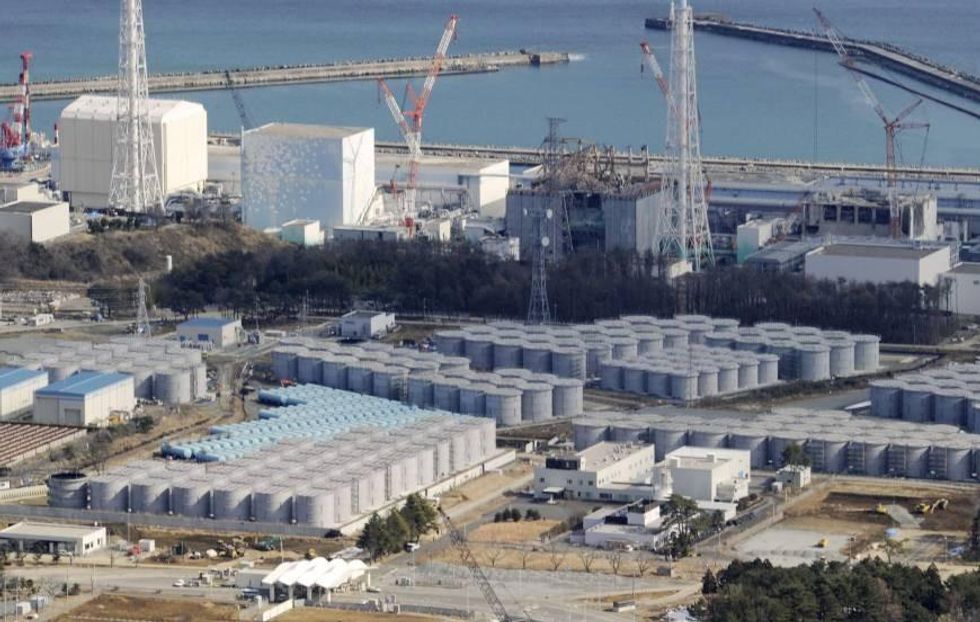'A Huge Amount of Radiation' as Fukushima Crisis Worsens
Fukushima crisis only continues to worsen as a new and separate leak of 'highly radioactive water' found

That is the dangerous water cycle now taking place in Japan as huge amounts of water are being used to cool the damaged reactors and fuel rods remaining at the Fukushima plant with no safe way to contain, dispose, or deal with the thousands of tons of growing waste.
And the catastrophe only continues to worsen as reports from Japan on Tuesday indicate that a new and separate leak of "highly radioactive water" is now occuring from a storage tank with officials saying the undetected leak may have be allowing tons of contaminated water to seap into the ground every day for a month, or longer.
The new leak is separate from the ones reported in recent weeks, but may foretell a whole new series of worry, according to experts.
The water from the ongoing and latest leak, according to Reuters, "is so contaminated that a person standing 50 centimeters (1.6 feet) away would, within an hour, receive a radiation dose five times the average annual global limit for nuclear workers."
As the Japan Times reports:
At 9:50 a.m. Monday, Tepco workers on patrol found a pool of at least 120 liters of highly contaminated water thought to have escaped from concrete barrier's drain valves. The valves had been opened to drain rainwater.
The radiation level measured around 50 cm above the toxic water stood at about 100 millisieverts per hour, Tepco said.
Exposure to 100 millisieverts increases the incidence of death by cancer by 0.5 percent, according to the International Commission on Radiological Protection. It is also the legal upper limit for a nuclear worker over five years.
On Tuesday, Tepco said the water level in tank No. 5 had dropped by 3 meters, meaning about 300 tons of contaminated water had been lost. From Monday to Tuesday, about 10 tons were lost, indicating this amount may have leaked every day over the past 30 days, a senior Tepco official told The Japan Times.
"So far, we had four similar (tank) leakage cases. The problem this time is that we didn't detect it for as long as 30 days," the official said.
"That is a huge amount of radiation. The situation is getting worse," Michiaki Furukawa, professor emeritus at Nagoya University and a nuclear chemist, told Reuters.
And Reuters adds:
Massive amounts of radioactive fluids are accumulating at the Fukushima plant as Tepco floods reactor cores via a jerry-rigged system to keep melted uranium fuel rods cool and stable.
The water in the improvised cooling system then flows into basements and trenches that have been leaking since the disaster.
Highly contaminated excess water is pumped out and stored in steel tanks on elevated ground away from the reactors, which lie adjacent to the coast. About 400 tons of radioactive water per day has been pooling and kept in storage at Fukushima.
In order to keep up with the pace of the contaminated water flow, Tepco has mostly relied on tanks that are bolted together with plastic sealing around the joints. Those tanks are less robust -- but quicker to assemble -- than the welded tanks that the utility has recently started installing.
____________________________________________
An Urgent Message From Our Co-Founder
Dear Common Dreams reader, The U.S. is on a fast track to authoritarianism like nothing I've ever seen. Meanwhile, corporate news outlets are utterly capitulating to Trump, twisting their coverage to avoid drawing his ire while lining up to stuff cash in his pockets. That's why I believe that Common Dreams is doing the best and most consequential reporting that we've ever done. Our small but mighty team is a progressive reporting powerhouse, covering the news every day that the corporate media never will. Our mission has always been simple: To inform. To inspire. And to ignite change for the common good. Now here's the key piece that I want all our readers to understand: None of this would be possible without your financial support. That's not just some fundraising cliche. It's the absolute and literal truth. We don't accept corporate advertising and never will. We don't have a paywall because we don't think people should be blocked from critical news based on their ability to pay. Everything we do is funded by the donations of readers like you. Will you donate now to help power the nonprofit, independent reporting of Common Dreams? Thank you for being a vital member of our community. Together, we can keep independent journalism alive when it’s needed most. - Craig Brown, Co-founder |

That is the dangerous water cycle now taking place in Japan as huge amounts of water are being used to cool the damaged reactors and fuel rods remaining at the Fukushima plant with no safe way to contain, dispose, or deal with the thousands of tons of growing waste.
And the catastrophe only continues to worsen as reports from Japan on Tuesday indicate that a new and separate leak of "highly radioactive water" is now occuring from a storage tank with officials saying the undetected leak may have be allowing tons of contaminated water to seap into the ground every day for a month, or longer.
The new leak is separate from the ones reported in recent weeks, but may foretell a whole new series of worry, according to experts.
The water from the ongoing and latest leak, according to Reuters, "is so contaminated that a person standing 50 centimeters (1.6 feet) away would, within an hour, receive a radiation dose five times the average annual global limit for nuclear workers."
As the Japan Times reports:
At 9:50 a.m. Monday, Tepco workers on patrol found a pool of at least 120 liters of highly contaminated water thought to have escaped from concrete barrier's drain valves. The valves had been opened to drain rainwater.
The radiation level measured around 50 cm above the toxic water stood at about 100 millisieverts per hour, Tepco said.
Exposure to 100 millisieverts increases the incidence of death by cancer by 0.5 percent, according to the International Commission on Radiological Protection. It is also the legal upper limit for a nuclear worker over five years.
On Tuesday, Tepco said the water level in tank No. 5 had dropped by 3 meters, meaning about 300 tons of contaminated water had been lost. From Monday to Tuesday, about 10 tons were lost, indicating this amount may have leaked every day over the past 30 days, a senior Tepco official told The Japan Times.
"So far, we had four similar (tank) leakage cases. The problem this time is that we didn't detect it for as long as 30 days," the official said.
"That is a huge amount of radiation. The situation is getting worse," Michiaki Furukawa, professor emeritus at Nagoya University and a nuclear chemist, told Reuters.
And Reuters adds:
Massive amounts of radioactive fluids are accumulating at the Fukushima plant as Tepco floods reactor cores via a jerry-rigged system to keep melted uranium fuel rods cool and stable.
The water in the improvised cooling system then flows into basements and trenches that have been leaking since the disaster.
Highly contaminated excess water is pumped out and stored in steel tanks on elevated ground away from the reactors, which lie adjacent to the coast. About 400 tons of radioactive water per day has been pooling and kept in storage at Fukushima.
In order to keep up with the pace of the contaminated water flow, Tepco has mostly relied on tanks that are bolted together with plastic sealing around the joints. Those tanks are less robust -- but quicker to assemble -- than the welded tanks that the utility has recently started installing.
____________________________________________

That is the dangerous water cycle now taking place in Japan as huge amounts of water are being used to cool the damaged reactors and fuel rods remaining at the Fukushima plant with no safe way to contain, dispose, or deal with the thousands of tons of growing waste.
And the catastrophe only continues to worsen as reports from Japan on Tuesday indicate that a new and separate leak of "highly radioactive water" is now occuring from a storage tank with officials saying the undetected leak may have be allowing tons of contaminated water to seap into the ground every day for a month, or longer.
The new leak is separate from the ones reported in recent weeks, but may foretell a whole new series of worry, according to experts.
The water from the ongoing and latest leak, according to Reuters, "is so contaminated that a person standing 50 centimeters (1.6 feet) away would, within an hour, receive a radiation dose five times the average annual global limit for nuclear workers."
As the Japan Times reports:
At 9:50 a.m. Monday, Tepco workers on patrol found a pool of at least 120 liters of highly contaminated water thought to have escaped from concrete barrier's drain valves. The valves had been opened to drain rainwater.
The radiation level measured around 50 cm above the toxic water stood at about 100 millisieverts per hour, Tepco said.
Exposure to 100 millisieverts increases the incidence of death by cancer by 0.5 percent, according to the International Commission on Radiological Protection. It is also the legal upper limit for a nuclear worker over five years.
On Tuesday, Tepco said the water level in tank No. 5 had dropped by 3 meters, meaning about 300 tons of contaminated water had been lost. From Monday to Tuesday, about 10 tons were lost, indicating this amount may have leaked every day over the past 30 days, a senior Tepco official told The Japan Times.
"So far, we had four similar (tank) leakage cases. The problem this time is that we didn't detect it for as long as 30 days," the official said.
"That is a huge amount of radiation. The situation is getting worse," Michiaki Furukawa, professor emeritus at Nagoya University and a nuclear chemist, told Reuters.
And Reuters adds:
Massive amounts of radioactive fluids are accumulating at the Fukushima plant as Tepco floods reactor cores via a jerry-rigged system to keep melted uranium fuel rods cool and stable.
The water in the improvised cooling system then flows into basements and trenches that have been leaking since the disaster.
Highly contaminated excess water is pumped out and stored in steel tanks on elevated ground away from the reactors, which lie adjacent to the coast. About 400 tons of radioactive water per day has been pooling and kept in storage at Fukushima.
In order to keep up with the pace of the contaminated water flow, Tepco has mostly relied on tanks that are bolted together with plastic sealing around the joints. Those tanks are less robust -- but quicker to assemble -- than the welded tanks that the utility has recently started installing.
____________________________________________

